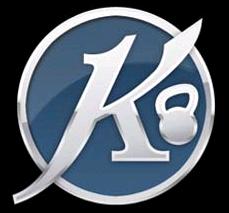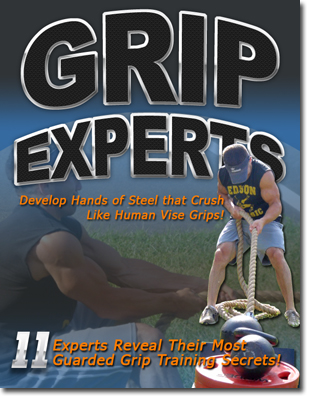paradox - A statement or situation which defies logic or reason
Today I am going to tell you about the Forearm Pain Paradox.
Imagine being able to bend spikes and steel bars with your hand and wrist strength, but not being able to turn a door knob to pen a door.
Imagine being able to lift a world record weight in a strength contest, but not being able to straight your arms to do so.
Finally, imagine being dog-tired from one of the best workouts you ever had, but not being able to fall asleep because your forearm hurts so bad you can't find a pain-free position.
All of these scenarios are things I have lived with over the years.
My name is Jedd Johnson, and I am from DieselCrew.com. I am a strength coach, and my passion is Grip Strength. I love bending nails, tearing cards and phone books and own world records in grip.
But I am also just like you. I know what it is like to have workouts hindered due to the annoying nagging pain that can happen up around the top of the forearm and elbow.
Chances are, if you have been training hard for a while, or if you do a lot of hand-intensive manual labor, you have had bouts of forearm pain like this too.
Maybe, you're even suffering from it right now.
Forearm pain, especially up near the elbow, creates what I call the Forearm Pain Paradox. What I mean is, you can have strong hands and wrists, and lower arms capabable of absolutely astonishing feats of strength and power, but your grip goes completely to shit when you have high forearm and elbow pain, especially medial and lateral epicondylitis. There are so many attachments in that small area near your elbow, if something goes wrong, it's like the strength you've worked to build up for years works against you.
The same goes for big movements, like bench press, overhead press, squats and deads. You can be a damn monster in the weight room, but if you get high forearm or elbow pain bad enough, you can kiss PR's goodbye...
Forearm pain SUCKS, and thousands of people get it each year. In my estimation, I have had what is referred to as medial and lateral epicondylitis, and more commonly known as Golfer's Elbow and Tennis Elbow, respectively, about 10 times since 2003.
The Causes of Forearm Injuries
I know a lot of you love getting into the meat and potatoes behind all of this stuff, so here it is in a nutshell.
Medial Epicondylits (ME) - Golfer's Elbow

M.E. is an injury to the common flexor tendon which originates from the medial epicondyle, a bony structure high on the elbow, and on the underside. That just means a lot of the flexor muscles start there. It also means that if you do a lot of movements where you are flexing your hands and wrists, you could end up with this problem. This is also caused by a valgus movements, where the forearm moves out away from the body, but the upper arm stays close to the body, like the back arm of the golf swing, which is why it's called Golfer's Elbow.
Lateral Epicondylitis (LE) - Tennis Elbow
L.E. is nearly the same as M.E., but the difference is that it takes place in the common extensors tendon, which is on the back of the forearm, and attaches on the top part of the elbow. This one is caused by rotation and extension movements. Even just straightening the arm can lead to it, so you don't need to rip, bend and tear things to cause issues. Just the basic pressing movements can do it. Tennis players get this because of the drag that takes place when swinging the racket in a back-hand strike.
What Can You Do about These Conditions?
Now that you know what these conditions are with their supped-up names and bad attitudes, it's time to discuss what to do about these conditions.
First and foremost, preventing these conditions is a lot more fun than getting them. Like I said, I have had both of these full-blown conditions about ten times over the years, from 2003 until 2009.
In 2003, I was bending steel and lifting stones like a mad man, but when it came to turning a door knob, my knees would buckly because of the pain. Several times, the pain was enough to keep me awake at night, and my most recent case of full-blown LE, the injury was so bad, that I needed to wear elbow sleeves with tiny heating packets in them in order to keep the area warm enough to straighten my arm to pick up weights from the floor.
In 2009, I decided I'd had enough of this crap, so once I rehabbed it that last time, I began implementing a battery of preventive exercises. I still do all of my feats and compete in Grip Sport contests, but now, I am smarter about it.
Surprisingly, the Preventive measures add almost no time to my training at all. They are so simple, I often wonder why I didn't start doing this stuff way back in 2003.
The principles I use involve promoting strength in the extensor muscles, which open the hand. This keeps a strength balance between the extensor muscles which open the hand and the flexor muscles which close the hand, and keeps the lateral epicondyle and the tendons that connect to it in good working shape.
Other things like a good warm-up and keeping the area warm during my training (also known as common sense) have paid huge dividends in my training, allowing me to train longer, miss fewer workouts, and compete at a higher level.
So, I have become very good on the Preventive side. In fact, I wanted to put together an ebook to help others prevent these types of injuries from occurring at the forearm and elbow, but I soon realized that it would be a complete waste of time for many people, because so many people are already bother by this kind of intense pain.
That was when I knew I had to track down somebody that was experienced at rehabbing this kind of injury. That was when I tracked down Rick Kaselj. Rick has many certifications behind is name, but that is not what is important. What really matters is the fact that he has already helped so many people in the past get through injuries.
I contacted Rick about putting together something with me for forearm injuries like this and he agreed. Within a short time, we had developed the main outline of Fixing Forearm Pain - Medial and Lateral Elbow Pain Fix for Athletes and Lifters.
Rick and I released this new product this week, and we know that there are a lot of you out there who are struggling with forearm pain. That is why we opened it up for this week at such a dirt cheap price - $19. That is less than my co-pay when I go to the doctor!
If you've had forearm/elbow pain for a while, you know how bad it can affect your training, strength levels, attitude, and night-time rest. Grab our ebook and study Rick's portion, where he outlines his professional approach to rehabbing elbow pain
And maybe you've never had pain like this, but you know that the training you do could one day cause something down the road. In that case, check out the manual and dive into my section, where I talk about the Preventive Methods I have used for the last couple years to keep high forearm and elbow pain from coming back.
I know this manual is going to help a lot of people, so make sure to get it before Friday, because then the price is going to increase.
All the best in your training,
Jedd
P.S. Don't be the "I'll wait to later" guy. You and I both know that later never comes, and if it does, it might be too late to grab















